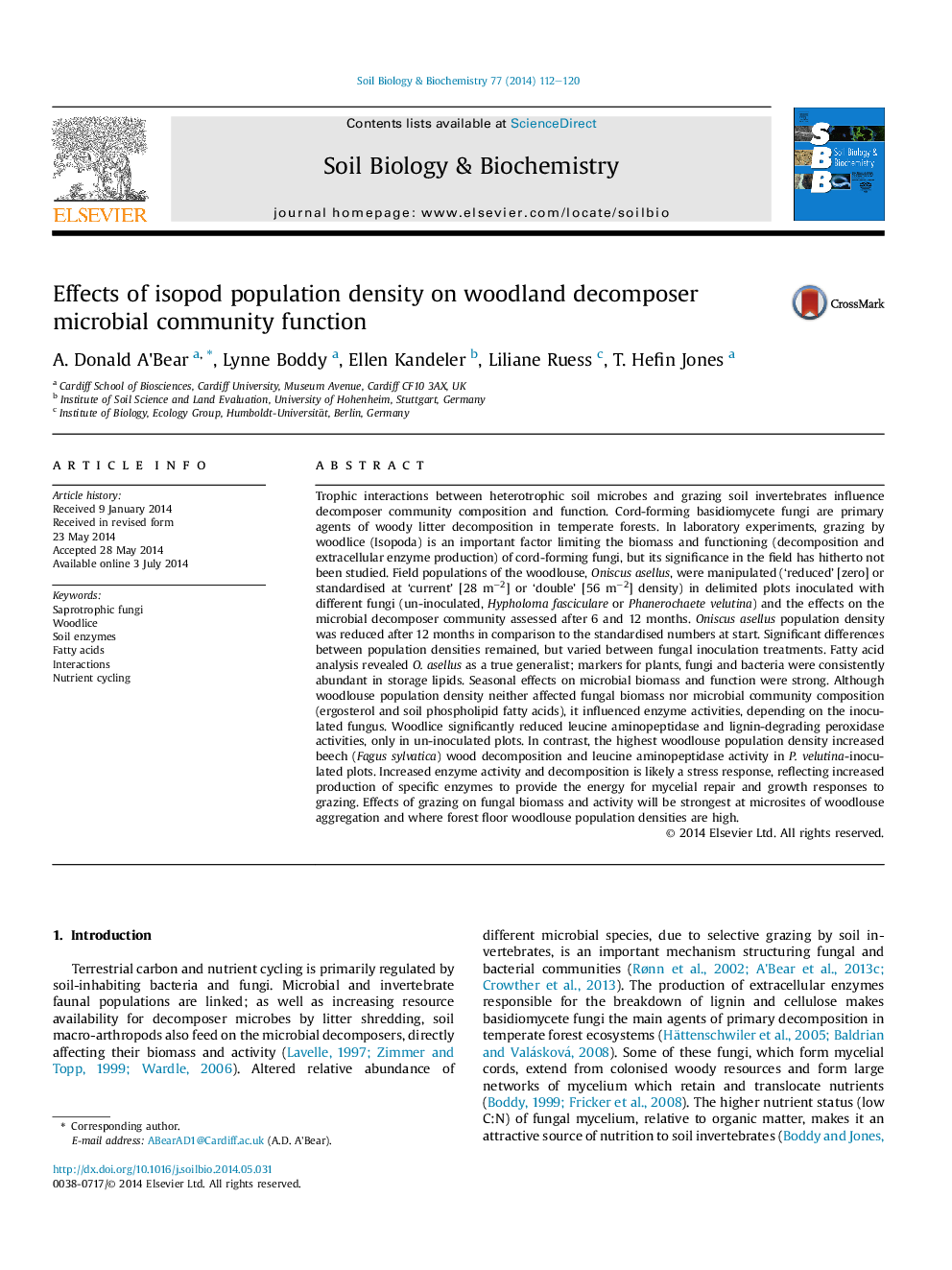| کد مقاله | کد نشریه | سال انتشار | مقاله انگلیسی | نسخه تمام متن |
|---|---|---|---|---|
| 8364484 | 1542607 | 2014 | 9 صفحه PDF | دانلود رایگان |
عنوان انگلیسی مقاله ISI
Effects of isopod population density on woodland decomposer microbial community function
ترجمه فارسی عنوان
اثرات تراکم جمعیت ایزوپود در عملکرد جامعه میکروبی تجزیه کننده جنگل
دانلود مقاله + سفارش ترجمه
دانلود مقاله ISI انگلیسی
رایگان برای ایرانیان
کلمات کلیدی
موضوعات مرتبط
علوم زیستی و بیوفناوری
علوم کشاورزی و بیولوژیک
دانش خاک شناسی
چکیده انگلیسی
Trophic interactions between heterotrophic soil microbes and grazing soil invertebrates influence decomposer community composition and function. Cord-forming basidiomycete fungi are primary agents of woody litter decomposition in temperate forests. In laboratory experiments, grazing by woodlice (Isopoda) is an important factor limiting the biomass and functioning (decomposition and extracellular enzyme production) of cord-forming fungi, but its significance in the field has hitherto not been studied. Field populations of the woodlouse, Oniscus asellus, were manipulated ('reduced' [zero] or standardised at 'current' [28 mâ2] or 'double' [56 mâ2] density) in delimited plots inoculated with different fungi (un-inoculated, Hypholoma fasciculare or Phanerochaete velutina) and the effects on the microbial decomposer community assessed after 6 and 12 months. Oniscus asellus population density was reduced after 12 months in comparison to the standardised numbers at start. Significant differences between population densities remained, but varied between fungal inoculation treatments. Fatty acid analysis revealed O. asellus as a true generalist; markers for plants, fungi and bacteria were consistently abundant in storage lipids. Seasonal effects on microbial biomass and function were strong. Although woodlouse population density neither affected fungal biomass nor microbial community composition (ergosterol and soil phospholipid fatty acids), it influenced enzyme activities, depending on the inoculated fungus. Woodlice significantly reduced leucine aminopeptidase and lignin-degrading peroxidase activities, only in un-inoculated plots. In contrast, the highest woodlouse population density increased beech (Fagus sylvatica) wood decomposition and leucine aminopeptidase activity in P. velutina-inoculated plots. Increased enzyme activity and decomposition is likely a stress response, reflecting increased production of specific enzymes to provide the energy for mycelial repair and growth responses to grazing. Effects of grazing on fungal biomass and activity will be strongest at microsites of woodlouse aggregation and where forest floor woodlouse population densities are high.
ناشر
Database: Elsevier - ScienceDirect (ساینس دایرکت)
Journal: Soil Biology and Biochemistry - Volume 77, October 2014, Pages 112-120
Journal: Soil Biology and Biochemistry - Volume 77, October 2014, Pages 112-120
نویسندگان
A. Donald A'Bear, Lynne Boddy, Ellen Kandeler, Liliane Ruess, T. Hefin Jones,
